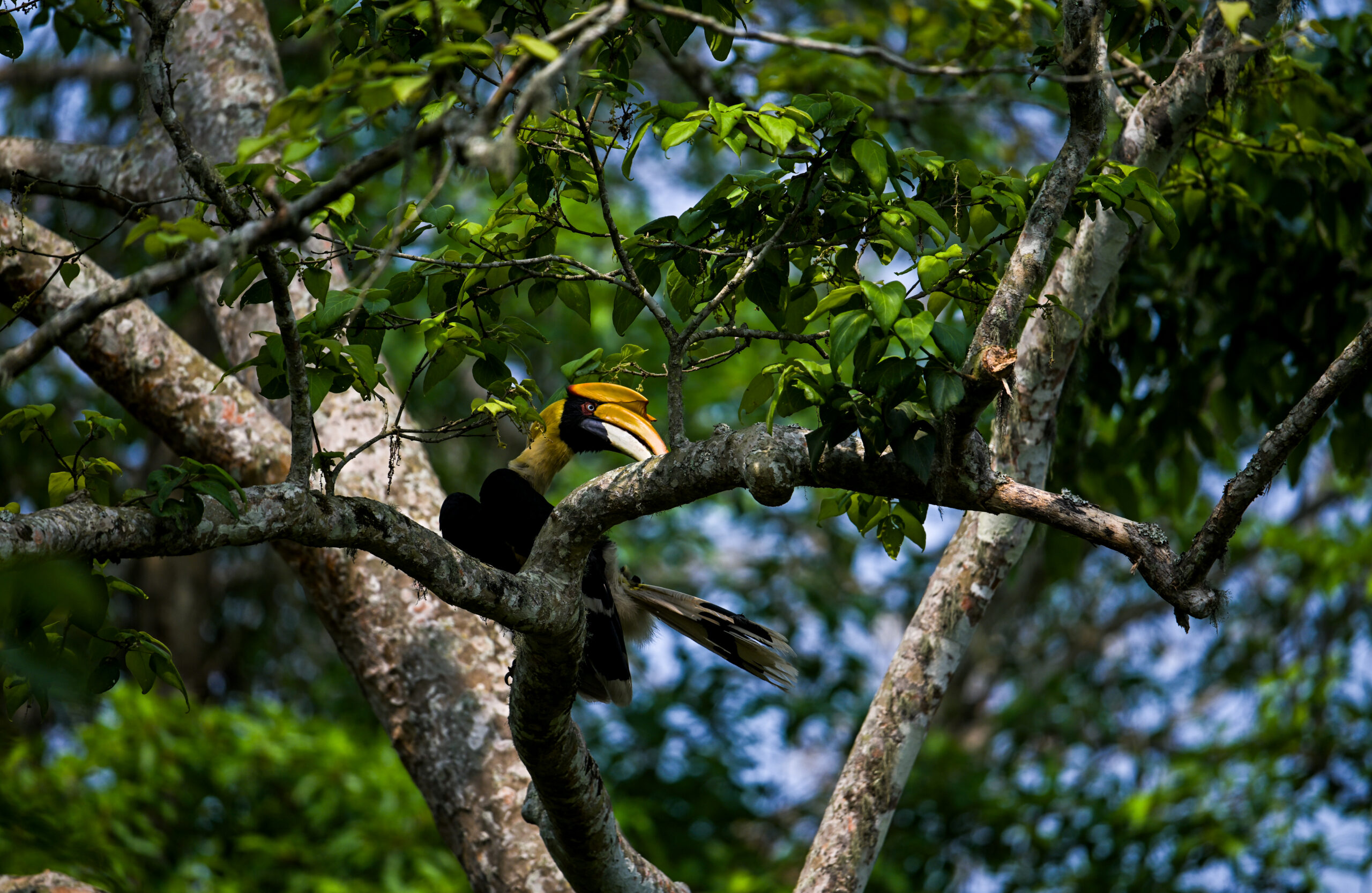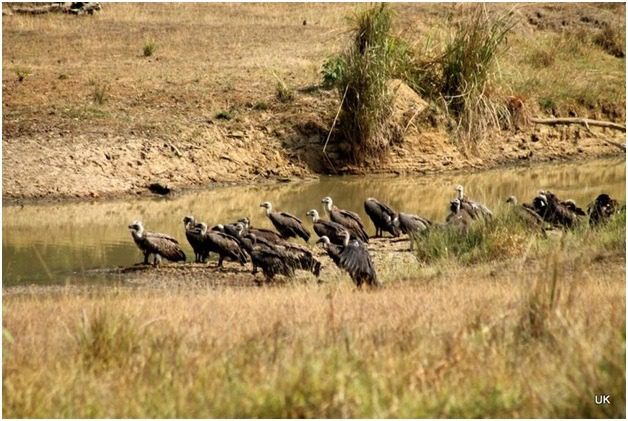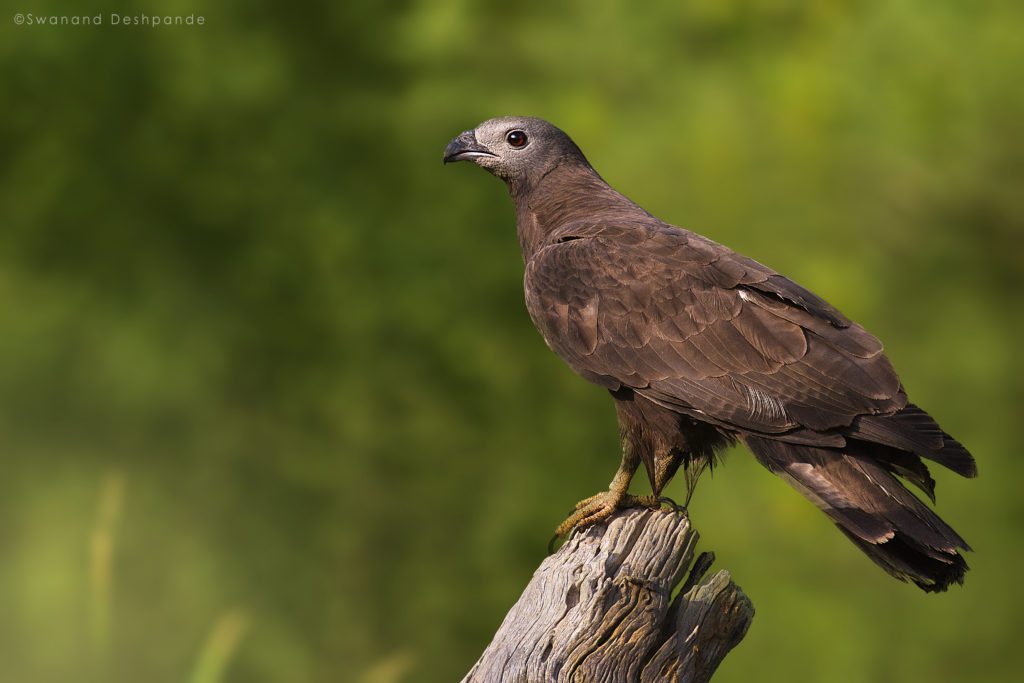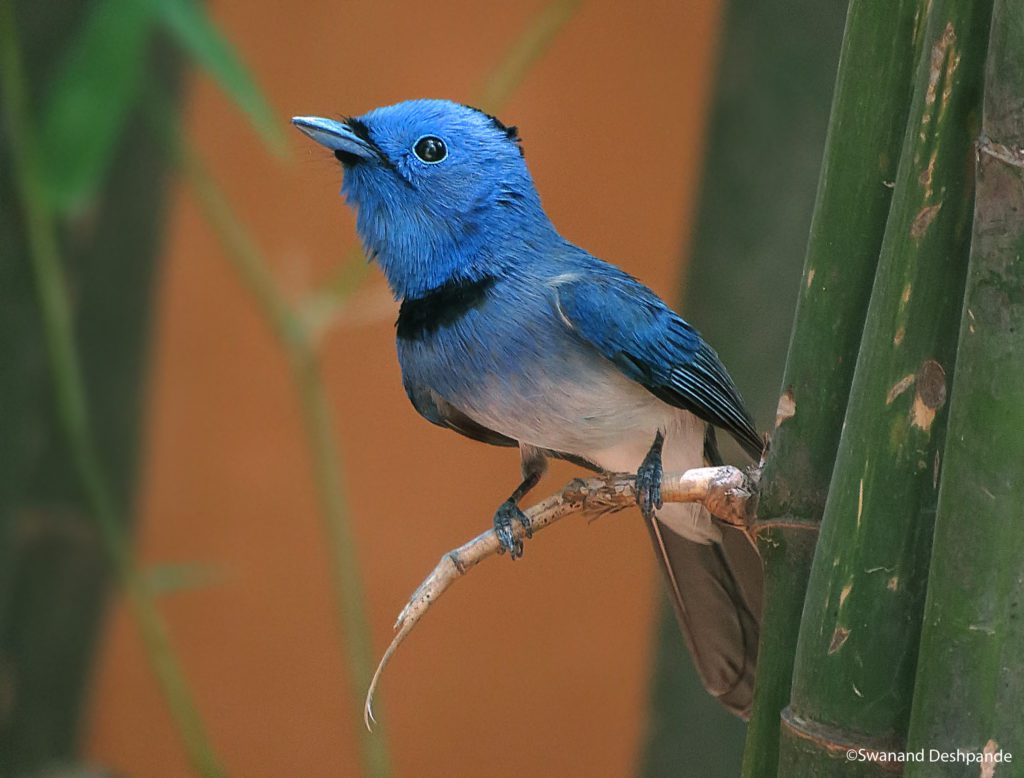In the emerald canopy, where silence reigns,
A regal bird with a horned crown claims
Through ancient woods, its call resounds,
A symphony of nature, where beauty abounds.
India is home to many remarkable creatures and is a country with a wide variety of landscapes and a wealth of biodiversity. Among these, hornbills in India stand out as iconic symbols of the nation’s rich bird variety. Nature lovers and birdwatchers alike are enthralled with hornbills due to their remarkable look, distinct behavior, and ecological significance. We will travel around the world of Indian hornbills in this blog, you will explore the world or hornbills in India, highlighting their beauty, biology, and conservation concerns.
Evolutionary origin and diversification of Hornbills
Early Origins: Based on the evidence found in fossil records, hornbills’ earliest progenitors most likely first emerged 56–66 million years ago, during the Paleogene era. Compared to present species, these early hornbills were smaller and more morphologically unified, most likely belonging to the order Bucerotiforme.
Diversification: Hornbills have developed and spread across continents, adapting to new habitats and ecological niches. According to fossil evidence, hornbills were formerly more widespread, with species found in Europe, Africa, and Asia. However, climate change and competition with other bird species may have resulted in the loss or decline of hornbill populations in certain areas.
Bill Evolution: A hornbill’s huge, curved bill with a casque on top is one of its most distinguishing characteristics. This unique bill shape most likely developed for intra-specific communication, fruit consumption, and prey capture. Though its precise purpose is still unknown, theories include responsibilities for the casque in thermoregulation, auditory signaling, and sexual selection.
Diversity of Hornbills in India
There are 62 species of Hornbills found all over the world, out of which 9 species of Hornbills are found in India, inhabiting the dense forests, wooded lands and Islands.
1. Great Indian Hornbill ( Buceros bicornis):
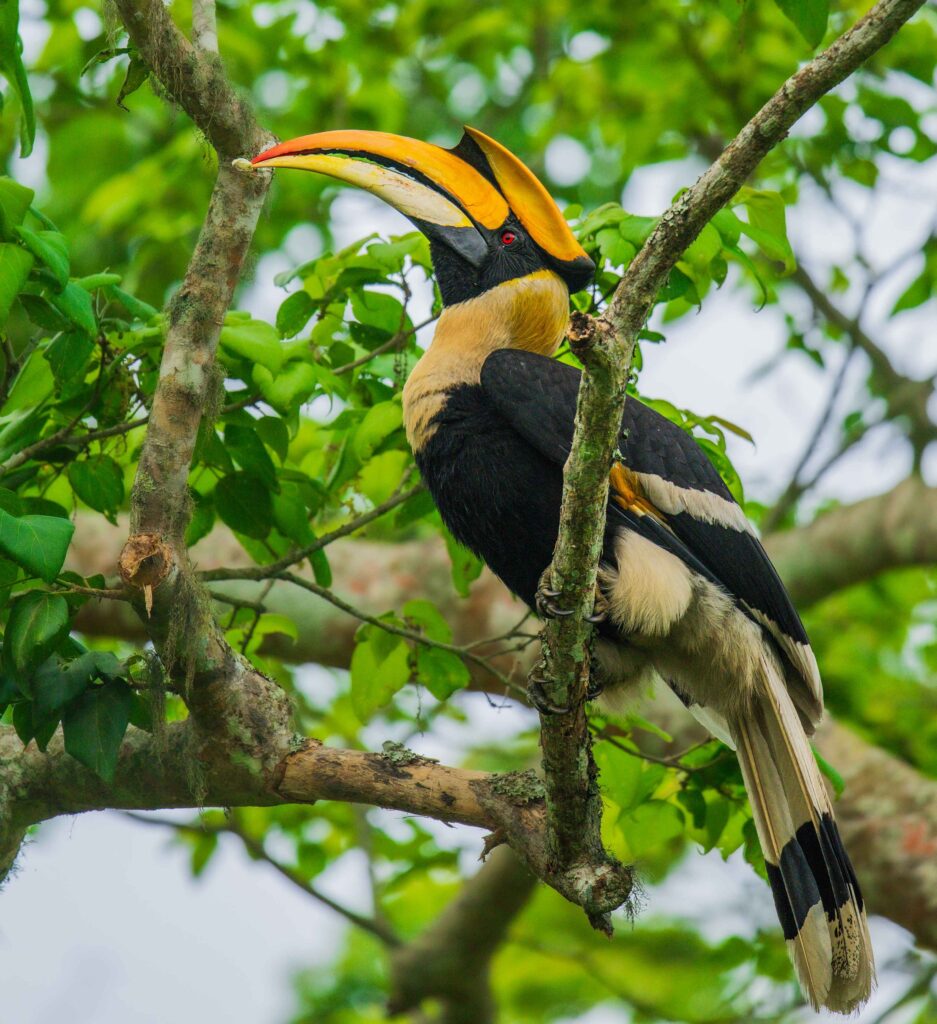
In India’s gorgeous green jungles, among the cacophony of bird cries and rustling leaves, there is a stunning winged species that claims attention with its sheer size, brilliant plumage, and distinguishable presence.
About: The Great Indian Hornbill is a sight to behold, with its gigantic size and stunning plumage. With black plumage and white underparts, it bears a dazzling casque atop its massive beak, giving it an intimidating and royal appearance. The casque, which is made of keratin, is assumed to have a role in vocalizations and courtship displays, making it an important part of the hornbill’s biology and behavior
Size: The Great Indian Hornbill is one of the biggest hornbill species, with males usually bigger than females. Adult males may reach a length of 95-120 cm (37-47 inches), including the tail, although females are somewhat smaller
Habitat: Great Indian Hornbills like deep forest habitats, which include both primary and secondary forests. They like places with many of fruiting trees for food and huge, old trees for nesting. They are commonly associated with undisturbed forest ecosystems, although they may also thrive in fragmented forest settings.
Distribution: Great Indian Hornbills are found in various forested regions across India. They are particularly prevalent in the Western Ghats, Eastern Ghats, Himalayan foothills, Northeast India, and parts of Central India. They inhabit states such as Kerala, Karnataka, Tamil Nadu, Assam, Arunachal Pradesh, Meghalaya, Nagaland, Manipur, Mizoram, Tripura, West Bengal, Odisha, Maharashtra, and Uttar Pradesh.
Outside of India, Great Indian Hornbills are also found in several countries in Southeast Asia. This includes Nepal, Bhutan, Bangladesh, Myanmar, Thailand, Laos, Cambodia, Vietnam, Malaysia, and Indonesia (specifically Sumatra and Borneo)
Diet: Great Indian Hornbills feed mostly on fruits, particularly figs. They perform an important role in seed distribution by digesting fruits and excreting seeds over a large region, which helps to regenerate forest ecosystems. They also consume small animals, birds, reptiles, and insects, especially during the mating season, when they require more protein for themselves and their offspring.
Breeding and Reproduction: The Great Indian Hornbill is monogamous and forms long-term mate relationships. They normally reproduce once a year, with the breeding season coinciding with the start of the monsoon. They build their nests in natural tree hollows, which are frequently found high up in old-growth trees. The female chooses the nest site, and the male and female collaborate to prepare the nest for egg-laying and nurturing their offspring.The female closes herself within the nesting chamber with her droppings, mud, and food remnants, leaving a tiny opening through which the male feeds her and the young. This behavior protects the mom and her offspring from predators.
Clutch size: 1 to 2 eggs
Incubation period: 38 to 40
IUCN status – Near threatened
Also Read: Top Birds in Satpura
2. The Malabar Pied Hornbill (Anthracoceros coronatus) :
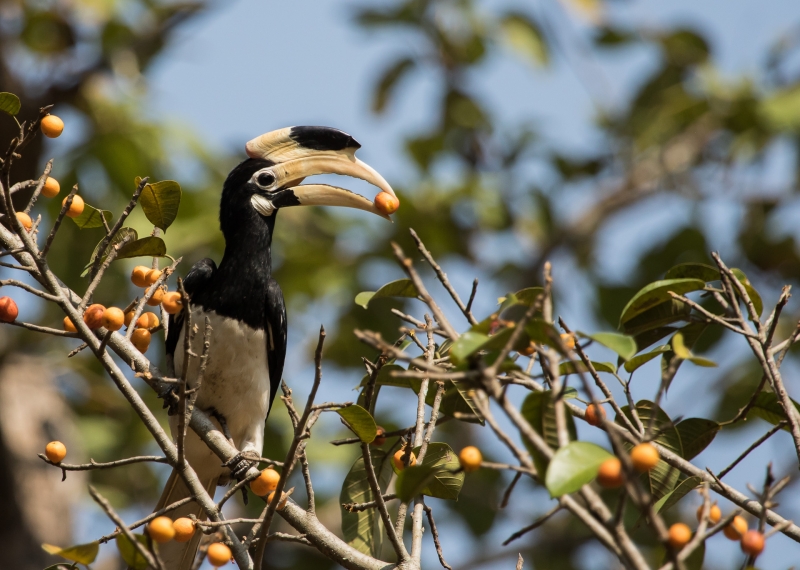
About: The Malabar Pied Hornbill (Anthracoceros coronatus) is a striking bird species characterized by its large size, distinctive black-and-white plumage, and prominent casque on top of its bill. The tail feathers are also black with white tips. Additionally, males have a larger white area on their wings, extending from the primaries to the secondaries, whereas females have smaller white patches.
Size: Malabar Pied Hornbills are big birds, with males being larger than females. They are generally 65 to 80 centimeters (25 to 31 inches) long, including their tail feathers, with a wingspan of 15 to 20 centimeters (6 to 8 inches).
Habitat: Malabar Pied Hornbills live in tropical and subtropical wet broad leaf forests, both evergreen and deciduous. They can also be found in woodland areas near bodies of water like rivers and lakes. Within their habitat, they seek deep canopy cover and large trees for breeding and roosting.
Distribution: The Malabar Pied Hornbill is primarily found in the Western Ghats region of India and parts of Sri Lanka.The Malabar Pied Hornbill is commonly found in the dense forests and wooded habitats of this region. Its distribution extends across several states in the Western Ghats, including Kerala, Karnataka, Tamil Nadu, and Goa. Within these states, it inhabits both evergreen and deciduous forests, as well as areas near water bodies.In Sri Lanka, the Malabar Pied Hornbill is found in the southwestern part of the island, particularly in the wet zone forests.
Diet: The diet of Malabar Pied Hornbills consists mainly of fruits, supplemented with small vertebrates, insects, and occasionally small reptiles.
Breeding and Reproduction:
Breeding in Malabar Pied Hornbills typically occurs during the dry season, which in their habitat in the Western Ghats of India and parts of Sri Lanka, generally spans from December to April. This period coincides with the availability of abundant food resources, such as fruits and insects.
Clutch Size: Malabar Pied Hornbills usually lay one to three eggs in each breeding season,After the eggs are deposited, both the male and female take turns incubating them for around 25 to 30 days. Once the chicks hatch, both parents care for them, feeding them regurgitated food alternately. The chicks stay in the nest cavity for several weeks before they are ready to fledge.
IUCN status – Least concerned
Also Read: 10 Backyard Birds At Pench Tree Lodge
3. The Oriental Pied Hornbill (Anthracoceros albirostris)
About: It has a huge, sturdy body with a long tail and wide wings. The Oriental Pied Hornbill’s most prominent characteristic is its black-and-white plumage, which gives it a strong and unusual look. The head, neck, wings, and upper body are glossy black, whereas the belly and tail are white. The bill is large and curved, with a yellowish-white base and black tip. The eyes are surrounded by naked skin that can vary in hue from blue to reddish.
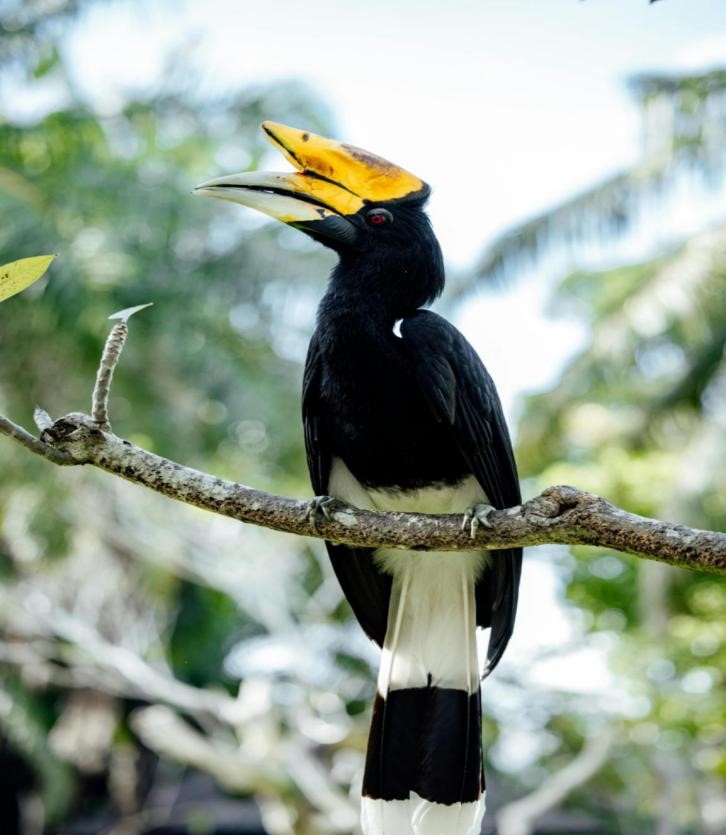
Size: The Oriental Pied Hornbill is a medium-sized bird, measuring around 55 to 65 centimeters (22 to 26 inches) in length, Male and female Oriental Pied Hornbills have similar plumage, making them difficult to distinguish based on appearance alone. However, males are slightly larger than females on average.
Habitat: Oriental Pied Hornbills inhabit a variety of forested habitats, including tropical and subtropical moist forests, mangrove forests, and even secondary forests. They are also found in wooded areas near rivers and streams. They prefer areas with tall trees for nesting and roosting and often occur in both lowland and montane regions.
Distribution: The Oriental Pied Hornbill has a wide distribution across Southeast Asia. Its range includes countries such as India, Thailand, Malaysia, Indonesia (including Sumatra, Borneo, and Java), Myanmar, Cambodia, Laos, Vietnam, and the Philippines.
In India, the Oriental Pied Hornbill is primarily found in the northeastern states and the Andaman and Nicobar Islands, particularly in the states of Assam, Arunachal Pradesh, Nagaland, Manipur, Mizoram, and Meghalaya. It occurs in various forested habitats, including tropical and subtropical moist forests, evergreen forests, and mixed deciduous forests.
Diet: The Oriental Pied Hornbill is an opportunistic eater that eats a variety of fruits, small vertebrates, insects, and invertebrates. This nutritional adaptability enables them to respond to changing environmental conditions and assures their survival in their woodland home.
Breeding and Reproduction:
Breeding in Oriental Pied Hornbills typically occurs during the dry season, which in their habitat in Southeast Asia generally spans from December to April.Oriental Pied Clutch size: Hornbills usually lay two to three eggs in each breeding season. However, the most common clutch size observed in the wild is two eggs. Clutches of four eggs are less common but have been documented in certain cases. The nesting behaviour is same as Malabar pied Hornbill.
IUCN status: Least concerned
Also Read: Birds Of Kanha National Park
4. The Indian Grey Hornbill (Ocyceros birostris):
About: As their name suggests, Indian Grey Hornbills have predominantly grey plumage, which is lighter on the belly and darker on the wings and back. They have a white or pale yellow patch on their cheeks, which contrasts with their dark eye and bill. The tail feathers are white with broad black tips, and the wings have black primary feathers,males may have slightly larger and more pronounced casques compared to females.
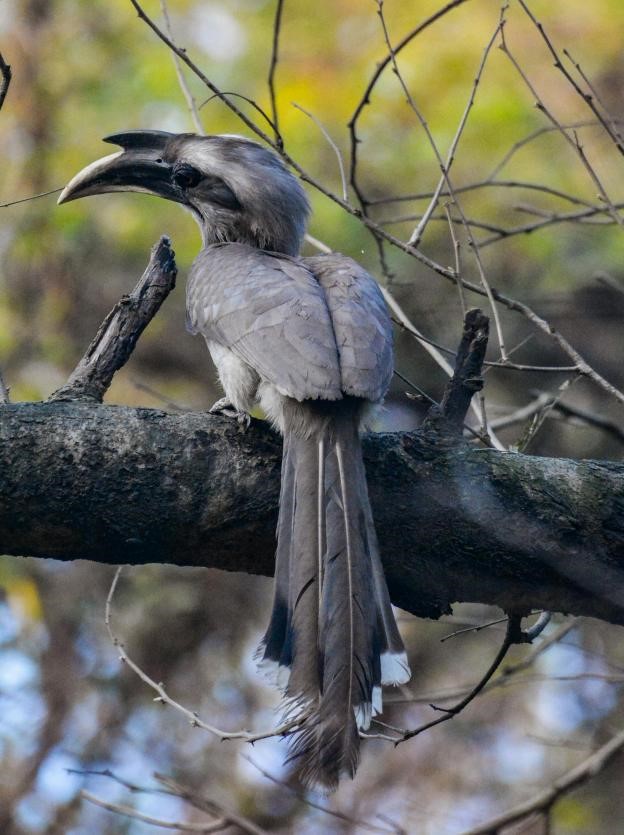
Size: Indian Grey Hornbills are medium-sized birds, measuring approximately 45 to 58 centimeters (18 to 23 inches) in length, including their long tail feathers. They have a robust body with a large head and a long, curved bill. The bill is black with a yellow base and a casque (a hollow structure) on top.
Habitat: Indian Grey Hornbills live in a wide range of forested environments, including tropical and subtropical dry forests, scrub forests, savannas, and wooded areas near human settlements. They can also be found in cities and suburbs where trees are appropriate for breeding and foraging. However, they are uncommon in thick rainforests.
Distribution: : The Indian Grey Hornbill is distributed across the Indian subcontinent, including India, Nepal, Bhutan, Bangladesh, and parts of Pakistan and Sri Lanka. Within India, it is found in various states across the country, ranging from the Himalayan foothills in the north to the Western Ghats in the south and from the Thar Desert in the west to the forests of Northeast India in the east.
Diet:Their diet primarily consists of fruits, insects, small mammals, and reptiles. Figs are a favorite food for many hornbill species, including the Indian Grey hornbill
Breeding and Reproduction: Breeding in Indian Grey hornbills usually happens during the dry season, which varies by area. They may, however, breed all year in regions with ideal weather and food supply.After sealing herself inside the nest, the female lays eggs, which usually range from two to four each clutch. The incubation phase lasts around 25 to 30 days, during which time the male supplies food for the female and occasionally takes over incubation chores while she takes brief breaks outside the nest.
The chicks stay in the nest for 50 to 60 days before they fledge. After fledging, they may continue to rely on their parents for food and supervision as they learn to forage and navigate their environment.
IUCN status: Least concerned
Also Read: Cobra Snake in India
5. The Malabar Grey hornbill (Ocyceros griseus):
About: As the name suggests their plumage is predominantly Grey, with a darker shade on their wings and tail. The underparts are lighter Grey, often with a bluish tinge. They may also have a slight olive-green hue on the back.
They possess a distinctively large, pale yellow or white bill with a casque, a hollow structure on top, which is more prominent in males.
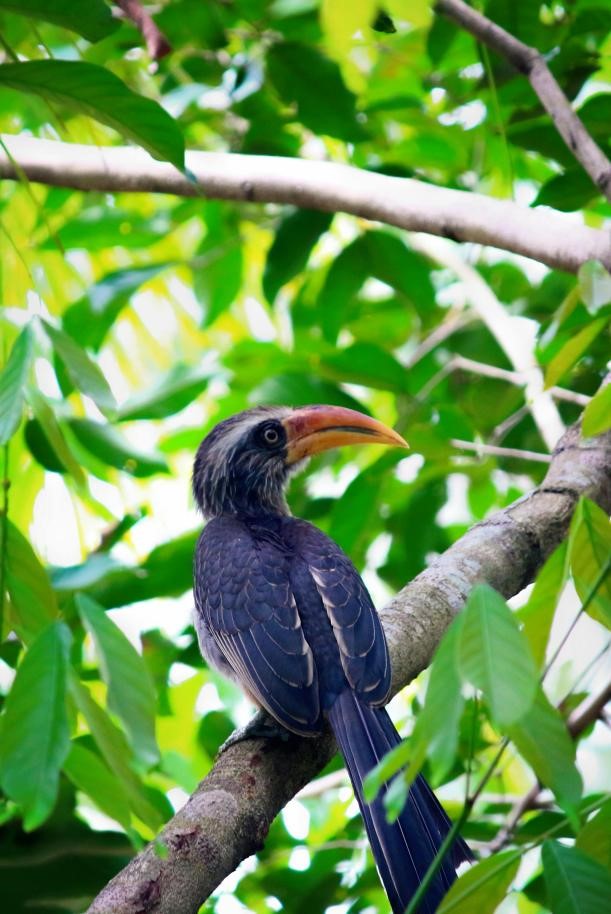
Size: Malabar Grey hornbills are medium-sized birds, measuring approximately 50–60 cm (20–24 inches) in length.Males and females are generally similar in appearance, although females may have slightly smaller casques.
Habitat: Malabar Grey hornbills live mostly in the Western Ghats’ deep, damp evergreen and deciduous woods. They live in both lowland and mid-elevation woods, preferring places with abundant fruiting trees for foraging.
Distribution: Endemic to the Western Ghats of India, Malabar Grey hornbills are found in the states of Kerala, Karnataka, Tamil Nadu, and Goa. Their distribution is closely tied to the availability of suitable forest habitat within this region.
Diet: Their diet consists mainly of fruits, but they also consume insects, small reptiles, and occasionally small mammals and birds. They play a vital role in seed dispersal within their ecosystem.
Breeding and Reproduction: Malabar Grey hornbills typically breed during the dry season, which in the Western Ghats of India generally falls between February and April. However, exact breeding times may vary depending on local conditions and food availability. Breeding pairs engage in elaborate courtship displays, which may involve mutual bill-wiping, aerial chases, and vocalizations.After courtship, the female lays a clutch of typically 2 to 3 eggs inside the sealed nest cavity.The female incubates the eggs, relying on the male to provide food for her during this period, which usually lasts around 25 to 30 days.The chicks fledge from the nest after about 50 to 60 days
IUCN Status: Near threatened
6. Narcondam hornbills (Rhyticeros narcondami):
Narcondam hornbills are a fascinating and severely endangered hornbill species found only on Narcondam Island, a tiny volcanic island in the Andaman Sea that is part of India’s Andaman and Nicobar Islands region.
Evolution of Narcondam hornbills
The development of Narcondam hornbills (Rhyticeros narcondami) is an intriguing subject that interweaves with the geological and biological history of Narcondam Island, the only spot on Earth where these birds can be found.]
Island Endemism: Narcondam Island, a tiny volcanic island in the Andaman Sea, has remained physically isolated for millions of years. This seclusion has resulted in the emergence of distinct species found nowhere else in the world, a process known as island endemism.
Island Colonization:It is thought that the progenitors of Narcondam hornbills came on the island by natural dispersal events such as flying or rafting over the sea. This original settlement most likely took place long ago, when the island was still connected to other landmasses.
Adaptation to the Island Environment: The hornbill population on Narcondam Island evolved genetically and ecologically as they adapted to the island’s unique environmental characteristics, such as its volcanic topography, climate, and food supplies.
About: They have predominantly black plumage, with white underparts and a distinctive white tail with a broad black band. Their bills are yellowish-orange with a prominent casque on top.Males and females look similar, but males typically have larger casques and brighter plumage.
Size: Narcondam hornbills are medium-sized birds, measuring around 65–70 cm (25–28 inches) in length
Habitat: Narcondam hornbills inhabit the dense tropical forests of Narcondam Island, which is characterized by its volcanic terrain and rich biodiversity.
Distribution: They are endemic to Narcondam Island and are not found anywhere else in the world. The island’s isolated nature has led to the evolution of unique species, including the Narcondam hornbill.
Breeding and Reproduction:
Breeding pairs engage in elaborate courtship displays, which may involve mutual bill-wiping, aerial chases, and vocalizations. These displays strengthen the pair bond and help synchronize breeding behavior.Before the female lays eggs, the pair selects a suitable nest site, often in a tall tree with a large cavity.The female lays a clutch of eggs, usually 2 to 3, The female incubates the eggs for around 25 to 30 days, relying on the male to provide food for her during this period. The chicks fledge from the nest after about 50 to 60 days
IUCN status: Critically Endangered
7. The Wreathed hornbill (Rhyticeros undulatus)
About: They have striking plumage characterized by black feathers with white streaks and bands on their wings and body. Their head and neck are predominantly black, while the rest of the body is adorned with vibrant hues of yellow, orange, and red., a black band around the gular skin, and a white tail. The female’s gular skin is blue, while the male’s is brilliant yellow; his neck is white, and his nape is dark reddish, fading to black. Sexual dimorphism in plumage coloration and inflated gular skin is less obvious in juvenile wreathed hornbills, but it becomes more noticeable as both sexes grow.
Size: Wreathed hornbills are medium to large-sized birds, measuring approximately 70–90 cm (27–35 inches) in length.
Habitat: Wreathed hornbills inhabit the dense tropical forests of Southeast Asia, including primary and secondary forests, as well as forest edges. They are typically found in lowland and foothill regions.
Distribution: Wreathed hornbills are distributed across a broad range, including countries such as Thailand, Malaysia, Indonesia, Myanmar, and parts of Indochina.
In India they are seen in the north eastern part of the country.
Diet: The wreathed hornbill mostly feeds on big fruit, with figs accounting for the majority of its diet. It eats more drupaceous fruits than any other hornbill species. It also occasionally consumes tiny creatures such as insects, crabs, snails, and reptiles, especially during the mating season. It forages in the forest canopy throughout its range, occasionally descending to feed small animals or recover fallen fruit. Tropical fruit richness varies widely by location and season, therefore the wreathed hornbill travels considerable distances to find locations with plentiful fruit.
Breeding and Reproduction:
The wreathed hornbill has an average clutch size of 1-3 eggs, which the female incubates and protects alone for 40 days. She raises only one chick and keeps it in the nest until it fledges at the conclusion of the nesting cycle, which lasts 111–137 days. Both parents stay with the young for several months after it leaves the nest.
IUCN Status: vulnerable
8. Austen’s Brown Hornbill (Anorrhinus austeni)
About: Austen’s Brown Hornbill is a medium-sized hornbill,Its plumage is predominantly brown, with black markings on the wings and tail. The bill is long and curved, with a casque on top.Males and females can be distinguished by their bill coloration, with males having a reddish-brown bill and females having a yellow bill.
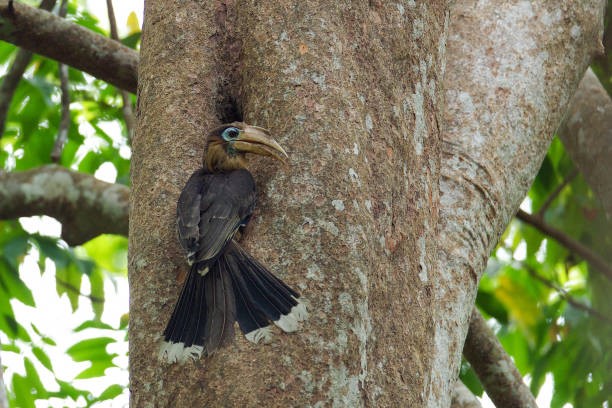
Size: Male 73-80 cm, female smaller. Male 710-900 g. Medium-sized hornbill with generally dark brown plumage and rufous underparts, wings and tail tipped white
Habitat: Austen’s Brown Hornbill primarily inhabits lowland forests and tropical rainforests, often favoring areas with dense canopy cover.
Distribution: from north-east India and south China across north Myanmar, north and central Thailand, Laos and west Cambodia to north-west Vietnam.
Behaviour: It is a social bird that lives in vocal and mobile groups of 2-15 birds, up to 50 in one group have been reported. In the non-breeding season a number of up to 80 birds can be seen roosting together in Khao Yai NP.
Diet:The Diet is mostly fruits, and 41 different types have been recognized. During a breeding survey in Thailand, the recorded food weight was 22% figs, 38% various fruits, and 40% animals. It swallows up to 41 different types of animal prey. Prey includes various arthropods, but also snails, earthworms, and vertebrate prey including bats, snakes, lizards, and bird chicks and eggs.
Breeding and Reproduction: The breeding season of the Austen’s brown hornbill is during March to June in India.The laying season is during February and March in Thailand, These species live in groups and only the dominant pair breeds while the other members of the group act as helpers. Some studies have indicated that the assistance by helpers-hornbills steadily increased the food-delivery rates during the breeding cycle.
The assistance from helpers, eventually increased the success of breeding and reduced the time required for the chicks to fledge.
IUCN status: Near Threatened
9. The Rufous-necked Hornbill (Aceros nipalensis)
About: Males of this species have reddish-brown heads, necks, and underparts; they are sexually dimorphic. Males have black upper parts with white-tipped outer primaries on their black wings.
The head, throat, and underparts of the female rufous-necked hornbill are all black. Although the youngsters’ plumage resembles that of males, their bills do not have black ridges. Adults have a long tail, with a black basal half and a white distal half.
the bill is pale yellow with a row of black, vertical ridges on the top mandible. The casque is hardly noticeable. The skin is gular and crimson. The skin on the orbits is pale blue, and the irises are reddish-brown.
Size: At 90 to 100 centimeters in length, the rufous-necked hornbill is one of the largest hornbill species.The male rufous-necked hornbill is slightly larger and weighs 2500 grams whereas the female weighs around 2200 grams
Habitat: There is a strong dependence on forests for these rufous-necked hornbill species. These species may be found between 150 and 2200 meters above sea level.
These hornbill species are found in a variety of natural environments, such as dry woods, deep evergreen forests, broadleaved forests, deciduous foothill forests, and tropical and subtropical wet montane forests.
Distribution: India, Nepal, Bhutan, China (southern Yunnan and south-east Tibet), Myanmar, Laos, Thailand, and Vietnam are among the countries where the rufous-necked hornbill species is found. In Nepal, it is most likely extinct, while in Vietnam, it is almost extinct. These species are found in northern West Bengal, Assam, Arunachal Pradesh, Nagaland, Manipur, and Mizoram in India.
Diet: Like other hornbill species, the Rufous-necked Hornbill has a varied diet consisting of fruits, figs, insects, small vertebrates, and sometimes small birds’ eggs.
Breeding and Reproduction: In northeastern India, the rufous-necked hornbill species breeds from March to June, A pair of hornbills may breed at the same location twice in a row. They are often seen in pairs or small family groups, sometimes associating with mixed-species flocks of birds while foraging.the female lays her eggs, usually one to three in number. She then incubates the eggs for about 35 to 40 days.
IUCN status: Vulnerable
Cultural Significance of Hornbills
Hornbills hold significant cultural importance across various societies and regions where they are found.
1.Mythology and Symbolism
Images of monarchy and Power: In many societies, hornbills are symbolic of leadership, monarchy, and power. They have become icons of strength and authority because to their remarkable size, stunning appearance, and distinctive mannerisms.
Spiritual and Religious Significance: Many indigenous tribes include hornbills in their mythology and spiritual beliefs. They are occasionally connected to gods or other supernatural entities and are frequently regarded as holy animals.
Relationship to Nature and Conservation: Hornbills represent the interdependence of humans and nature for a large number of indigenous peoples. Many people interpret their existence in the ecosystem as evidence of the harmony and health of the surroundings.
2. Cultural Practices and Traditions:
Ceremonial Attire and Artifacts: Many civilizations employ hornbill feathers, casques, and other body parts as decorations and artifacts. Their symbolic meaning and beauty make them valuable.
Traditional Medicine and Folklore: Different hornbill components are said to have therapeutic qualities or to be employed in traditional healing methods in particular tribes. These myths create problems for conservation because they encourage hornbill hunting and commerce.
Festivals and Rituals: In many festivals, rituals, and cultural events, hornbills take center stage. To recognize their significance and convey cultural identity, they could be included in dances, songs, and narratives.

Written & Contributed by: Shaheen Sheikh (Naturalist at Waghoba Eco Lodge)
Visit our the Luxurious Lodges in Different location:
The Best Resort in Kanha National Park, Luxury Resort in Tadoba, Resort in Bandhavgarh National Park, Resort in Pench, Resorts in Satpura, and Panna to watch various fascinating species of the forests frolic in the untamed wild.
Get in touch with our trip curators at Pugdundee Safaris to book your next wildlife holiday.
Our trip curators at Pugdundee Safaris are more than happy to assist you. Phone: +91-011-40132680 Email: [email protected]

